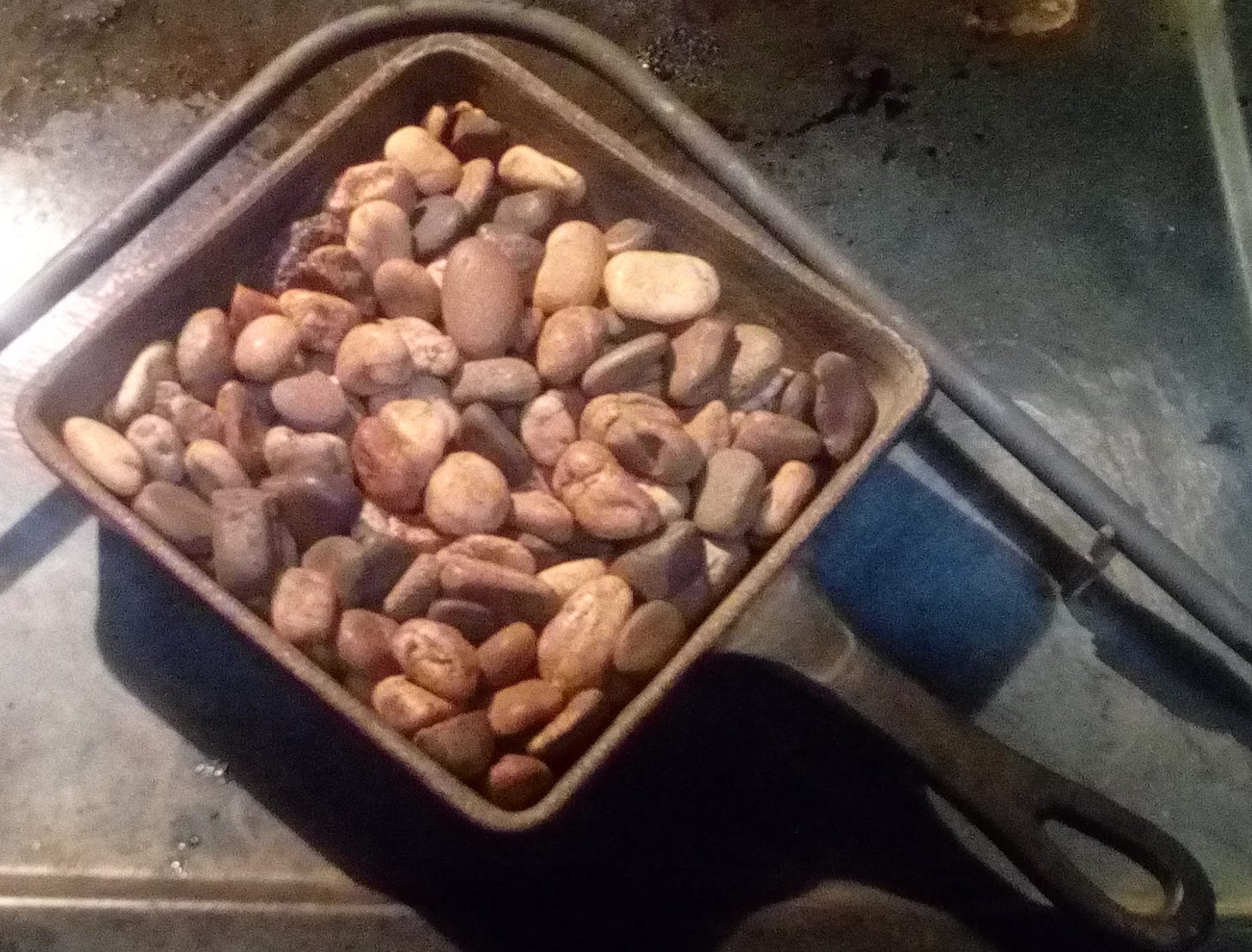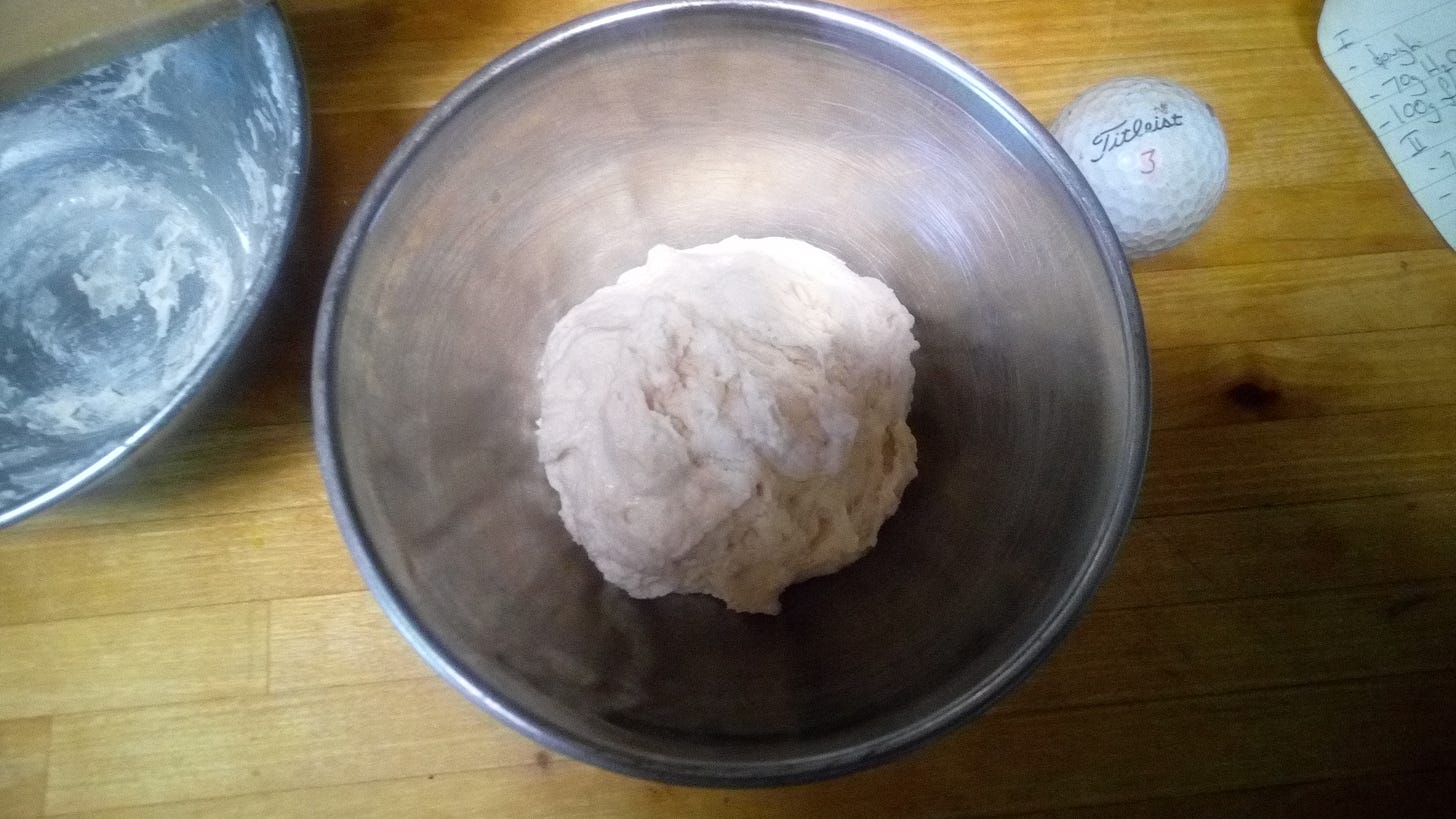Cooking is almost always an experiment. If I use a recipe I usually play fast and loose with it to see what I will get. Not so with recipes like this one. You do it this way.
I have a method for baguettes that I am happy with and thought I would share. The ingredients are simple; flour, water, yeast and salt. French bread is all about method. You can use this procedure, modifying the baking times, to make any French bread. I like baguettes. Also, this makes baguettes that I like. They are crusty, chewy and good.
This recipe makes five pain fendu, four nice baguettes, three ‘stalks of wheat’, two fat batards or a big round of crusty French bread. We’ll be making baguettes.
You will need, flour, water, yeast, salt, a bit of already risen dough and a proficiency with procedure.
Cautions:
You will be making steam. Please don’t burn yourself, so easy to do.
Steaming could wreck your oven.
Know this now: You need a golf ball sized bit of fully risen dough from bread (any bread) you already made to use as a starter. I keep some in a baggie in the freezer.
This recipe takes two days to make.
Bread is good. Bread is not good for you. I make these once a month.
Baguettes don’t keep. Eat ‘em up.
You will need to steam your oven. Let me say that again, you will need to steam your oven. Steaming the oven gives you the lovely crackly crust that makes baguettes the treat that they are. Steaming the oven can have detrimental effects on the oven. I’ve never experienced this but a friend has a daughter who ruined a perfectly good gas oven because of problems with the wiring. She now owns an artisinal bakery. We’re very proud of her. So it cost an oven. Cheap. We built a Quebec oven using this book...
This recipe uses a starter to make a sponge and develop flavour. So you have to make some bread before you make this bread. It is possible, in a kitchen that has seen bread production, to make bread with yeast magically conjured from the air. I won’t punish you, or myself, with that one. When it works it truly is magical. When it works.
Make sure you have everything you will need before you start.
What you need:
Ingredients: flour, water, salt, yeast, a bit of starter dough.
A scale for weighing ingredients.
A facility for steaming the oven, I use a small square cast iron pan filled with stones.
A large square of cloth for rising the baguettes ‘en couche’.
Something to cook the baguettes on.
Optional:
A pizza stone.
A pizza peel.
Rice flour.
Baguette pans or a big cookie sheet, or two.
Parchment.
A food processor or bread machine to knead your dough.
A pokey thermometer.
In a nutshell this is what you will be doing:
7-8 hours starter sponge
4 + 8 hours, feeding and growing the starter sponge (maybe get some sleep here)
1 1/2-2 hours, dough, rise
Shape
1 1/2 -2 hours, rise
Bake in a steamed oven.
Wait while your bread crackles and cools. Waiting is the hardest part.
General ramblings:
When I’m learning how to do things I hate it when the author sprinkles anecdotal crap in the method. I like to sprinkle anecdotal crap too so I’ll try to annoy you here rather than in the method. I have a book touted as the bible for French cooking that tells you what to do but doesn’t tell you how to do anything. It’s assumed that if you have that book you know. I’m not assuming that. I’m going to assume you know nothing and hope that isn’t true.
Modern French Culinary Art is a French chef’s bible. The Linux Kernel book is there so you will think that I am really smart.
The timing for some of the procedures here are more guidelines than rules. Bread does not recognise that you might have other things to do. If the dough doesn’t meet your expectations when rising, then you will have to adjust your schedule, the bread doesn’t care. Temperature, humidity and air pressure will affect rising times. If you are waiting for dough to double in size and it hasn’t done so in the time you allotted it’s probably not your fault, give it more time.
A good environment for rising bread dough is in an oven with the light on and, of course, the oven off. I’ll turn the house thermostat up a bit for when I can’t do that, like when the oven is heating up. Of course when the oven is heating up, so is your kitchen. My oven hovers around 88F with the light on, this is good.
You can knead the dough by hand. Kneading dough is cathartic. I get annoyed that I get a buildup of gluten on my hands, particularly with bread flour. This does not happen when you use a machine to do it.
When you couch the bread in the rising cloth, you want them close together so that they rise up giving a better shape. Round baguettes good, flat baguettes bad. Make sure there is enough of a fold so that when the baguettes rise up they don’t touch or they will stick together. If they do stick together, swear a bit and then wet the seam while you try to gently pry them apart. A sharp knife may be necessary. Best practice is not to let them stick together.
The rice flour, if you have it, is better than wheat flour for dusting your rising cloth and sliding the uncooked baguettes should you need to do that. Wheat flour tends to clump up and stick to the dough.
All purpose flour is fine but bread flour is better. Bread flour has more gluten in it. Gluten forms strands in the dough during the kneading process that give the bread the bubbly structure characteristic of French bread. It’s not a show stopper to use all purpose flour if you don’t have bread flour.
Speaking of show stoppers, steam is critical. Steaming your oven is a pain in the ass. Not steaming your oven is a show stopper. You won’t get lovely crusty bread if you don’t steam the oven. I have a small square cast iron pan that was originally purchased to cook eggs for sushi. Now it holds stones that I formerly used as pastry weights. I have nice glass beads for pastry weights.
Steam will piss you off royally if you get it on you. When you pour your hot water on the the hot pan make sure you have a good purchase on the container, make sure your hands are not going to be subjected to the steam and that your face is down and out of the way. A hazmat suit is good if you have one. Similarly, when you open the oven a minute or two later to insert the bread, DON’T steam your face. If that happens you can hate me if you like, it won’t affect me at all and you will have a burnt face.
Seriously, before you steam your oven, think about how you’re going to do it. Make sure you have room to stick the water jar in there and pour it out, so you can’t have a rack too low in the oven. I use a quart mason jar and a jar holder that I have for pressure cooking. I wear oven mitts. It’s hard to hold a jar of hot water with oven mitts on and pour the water out without dropping the jar so you need to make sure you have a good purchase. Thus the jar holder. The water overflows the pan I use and spreads out on the floor of the oven. You may notice in figure 7 above that there is some burnt sugar I couldn’t quite scrape up from my Christmas apple pie. I have my grandmother’s pie ring but I don’t know where it is.
Make sure you don’t pour water on the element.
When putting the bread in the oven I lay the baguettes on a square of parchment on a large pizza peel and slide the whole thing onto the pizza stone. If you are going to slide something into an oven and onto a pizza stone, make sure it is sliding well before you open the oven. If you have baguette pans or are using a cookie sheet you don’t need to worry about that. I have baguette pans, I have everything, but I prefer to lay them on a stone. Yes, I know where the baguette pans are.
Slashing the top of the baguettes. A razor is best. Slice from the middle of either end up to the sides and then decide if you are going to make one or two slashes in the middle. I brush water on the bread first and use a sharp knife that is kept clean and wet. I use a sharp knife as I can never find the razor. You want the slices to be fairly deep, these will be the places where the bread expands out as it bakes.
When you are shaping the dough try not to treat it too roughly. Stretch rather than pressing it out and when rolling it into shape cup your hands rolling it gently. We have made a nice glutinous structure that we want to preserve. This takes practice, it is worthy of note but don’t worry about it too much.
I bake the bread until the crust is a deep brown. You can use a thermometer that you can plunge into the bread, easiest on one of the slashes, looking for about about 200F. Less for a softer crust and wetter interior or longer for a harder crust and drier interior. It’s fairly forgiving here if nowhere else.
‘Mise en place’ is a French phrase meaning ‘Everything in place’. General cooking advice, before you do anything measure out the ingredients you are about to use so they are ready when you need to use them, also good for not forgetting to add an ingredient.
Baguettes are meant to be eaten the day they are made. They don’t keep. They will keep longer if you wrap them but they will turn soft, otherwise they turn into stale bread but it is a good shape for grating bread crumbs.
Method:
Make a sponge. 7 to 8 hours.
Ingredients:
70g water, 100g flour, your ball of starter dough. A small clean bowl.
Method:
Break the starter up and let it soften in the water. Mush the starter up and gradually add the flour. Mix well, No kneading required but mix it well so the starter is distributed.
Cover with plastic wrap and let it fester for 7 to 8 hours in a warm place.
Feed and rest the sponge. ~12 hours.
Ingredients:
70g water, 100g flour, the sponge from 1. A bigger clean bowl.
Method:
Incorporate the water and flour into the sponge, mixing well.
Cover with plastic wrap and let it sit for another four hours. At this point you can put it in the fridge for 8 hours.
Make and rise the dough. 2 hours.
Ingredients:
300g tepid water, 530g flour, 5g yeast, 1 tbsp kosher salt or to taste, the sponge, an even bigger clean bowl.
Method:
Start the yeast in the tepid water, five minutes should do it, you will know.
Add the the flour and mix well.
Let the mixture sit for ten minutes while the flour absorbs the water.
Add the sponge, mix, and knead for 15 minutes incorporating the salt.
Place the dough in a clean bowl, cover and rise in a warm place until the dough doubles in size. (about 1 1/2 hours)
This might be a good time to stash a ball of dough for your next batch.
Shape the dough, 2nd rise. 2 hours.
Method:
Flour your cloth, rub it in, shake off excess. Rice flour works best. Have it ready to couch your baguettes.
Divide the dough into four equal parts.
Work with one piece at a time covering the remaining dough with a cloth.
Stretch the dough into a rectangle.
Fold the dough towards you a couple times, press the seam with the palm of your hand and then pinch the seams. Tuck in and/or pinch the ends to tidy them up.
Roll the dough on your work surface until you get it to the length you want.
Place the dough in the couche seam side down, cover, and move on to the next piece.
Let the baguettes rise until doubled in size. (~1 1/2 hours)
***After an hour has passed preheat the oven to 450F.
Bake the baguettes.
Method:
Carefully move the baguettes from the couche onto whatever you are using. A dusted peel, parchment, baguette pans or cookie sheet(s) or whatever you like. Inserting the baguettes into a hot steamed oven can be a tricky operation.
Using a razor or a sharp knife, slash the baguettes 1/4” to 3/8” deep making about four diagonal slashes.
Steam the oven using a cup of hot water. Close the oven and give it a minute or two then place the baguettes in the oven keeping in mind all the shit I told you about how steam will fuck you up.
Bake the bread for about 1/2 hour or until the crust is a deep brown. If you wish you can poke it with a thermometer looking for about 200F.
Let the baguettes cool on a rack for as long as you can stand it, or 20 minutes.
If everything went well you now have lovely baguettes.
Cheers!










I love making baguettes - It's taken me over a decade to be able to make it consistently the way I like it. I can't buy bread in the store as it simply doesn't measure up. Love reading about other's thoughts on bread making. Recently I discovered everything spice - that takes baguettes to a whole new level for us around here
A bit advanced for me to try yet.
My mother had a couple different bread machines, they sucked. I tried a Kitchen Aid mixer for dough, .... I thought that sucked too. Glad it was a gift given to my now ex..
I don't like the sticky buildup on my hands kneading dough either, but I find that a couple drops of olive oil and rub my hands together, keeps it at bay for the most part.
I notice all the recipe's I find online have too many paragraphs of anecdotal bs that leaves me fast scrolling to the ingredients section. So your style of getting right to it, is SO refreshing.